Last updated on
Discover the effective way to maintain and restore the pristine beauty of your porcelain kitchen sink with these simple cleaning techniques.
Your kitchen sink is one of the most important fixtures in your home. It’s where you wash dishes, prep food, and even fill up a glass of water.
But over time, your sink can start to look dull and dirty, especially if it’s made of porcelain. Luckily, cleaning a porcelain kitchen sink is not as difficult as it may seem.
In fact, with just a few simple steps and some basic household items, you can have your porcelain sink looking shiny and new in no time! So let’s dive into the world of porcelain sinks and learn how to clean them like a pro!
What's Inside
Benefits of Porcelain Kitchen Sinks
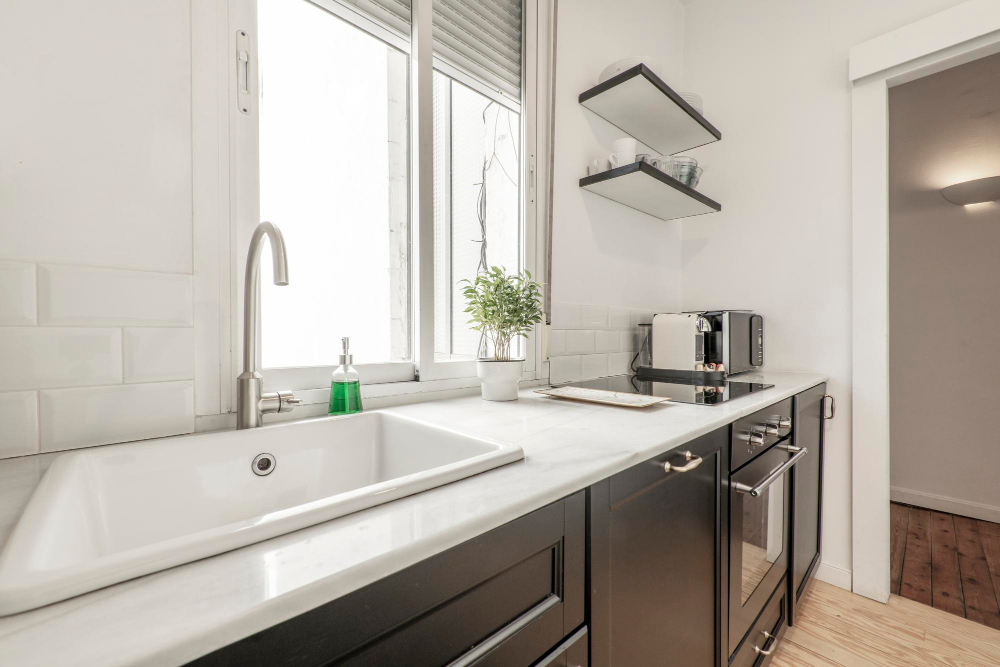
One of the biggest advantages of porcelain sinks is their durability. Porcelain is a hard, non-porous material that resists scratches, chips and stains better than other sink materials like stainless steel or cast iron.
Another benefit of porcelain kitchen sinks is that they come in a variety of colors and styles to match any decor. Whether you prefer classic white or something more bold and colorful, there’s sure to be a porcelain sink that fits your taste.
In addition to being durable and stylish, porcelain kitchen sinks are also easy to clean with just basic household items like baking soda or vinegar. This makes them an ideal choice for busy families who want low-maintenance fixtures in their homes.
Gather Cleaning Supplies
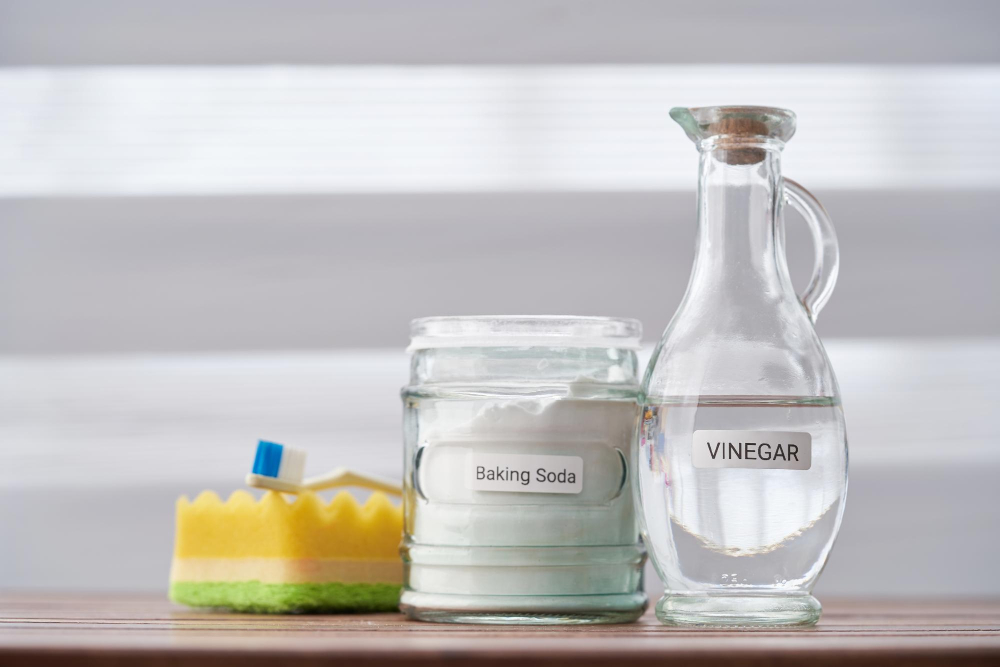
You don’t want to be halfway through the process and realize that you’re missing something crucial! Here are some of the items you’ll need:
- Baking soda
- White vinegar
- Soft sponge or cloth
- Rubber gloves (optional)
- Mild dish soap
These basic household items will help remove stains, grime, and other buildup from your porcelain sink without causing any damage or scratches on its surface.
Clear Out Debris
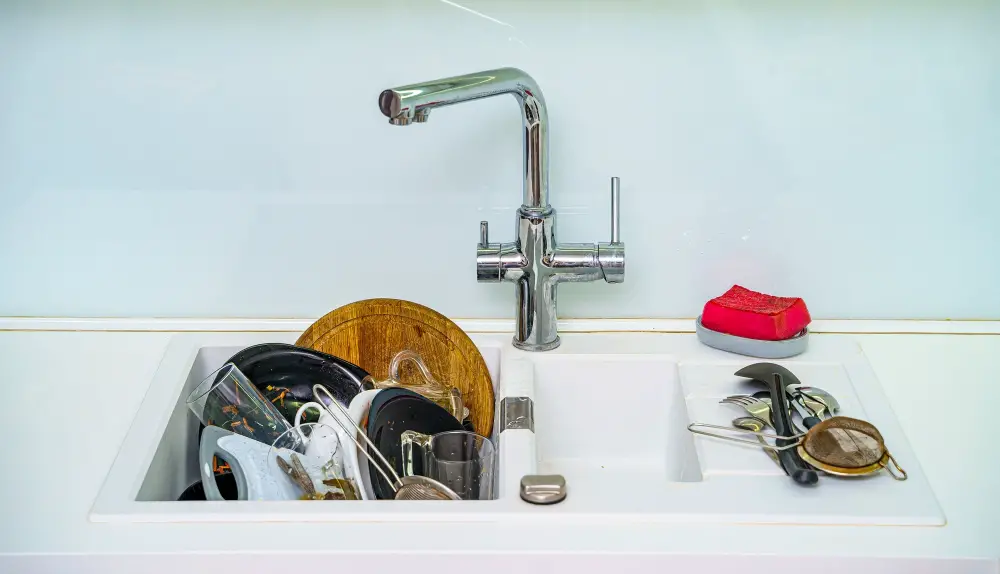
This includes food scraps, utensils, and anything else that might have found its way into the sink. Not only will this make it easier to clean your sink thoroughly but also prevent clogs from forming down the line.
To clear out debris from your porcelain kitchen sink, begin by removing any large items such as dishes or pots and pans. Then use a rubber spatula or scraper to remove any leftover food particles stuck on the surface of the basin.
Next up is clearing out smaller bits of debris like crumbs and dirt using a soft-bristled brush or sponge with warm water. Be sure not to scratch or damage your porcelain surface while doing so.
Wet the Sink Surface
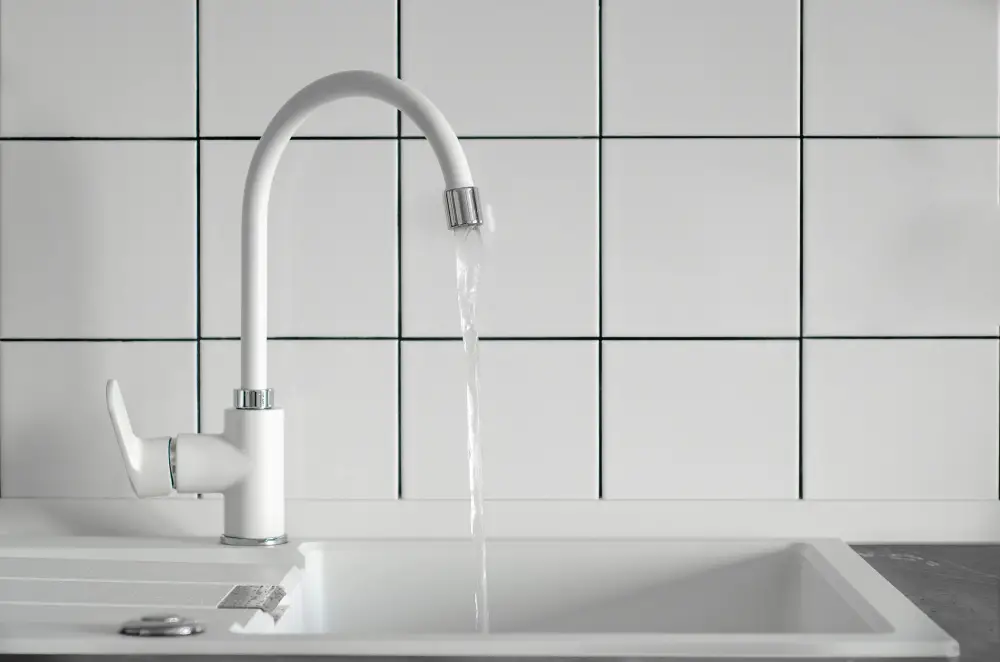
This will help loosen any dirt or debris that may have accumulated on the sink’s surface and make it easier to clean. To do this, simply turn on your faucet and let warm water run over the entire sink for a few minutes.
Make sure that you cover every inch of the porcelain with water so that all areas are equally moistened. You can also use a spray bottle filled with warm water if you prefer.
Wetting your porcelain kitchen sink before cleaning is an essential step in ensuring effective results without damaging its delicate finish. By doing so, you’ll be able to remove even stubborn stains more easily while keeping scratches at bay.
Choose a Cleaner

There are many commercial cleaners available in the market that claim to clean porcelain sinks effectively. However, some of these products contain harsh chemicals that can damage your sink’s finish over time.
To avoid this, you can make your own cleaning solution using natural ingredients such as baking soda or vinegar. Baking soda is an excellent abrasive cleaner that helps remove stains and grime without scratching the surface of your porcelain sink.
Vinegar is also a great natural cleaner with acidic properties that help dissolve mineral deposits and soap scum.
To use baking soda as a cleaner for your porcelain kitchen sink, sprinkle it generously on the wet surface of the sink and scrub gently with a soft sponge or brush until all stains are removed. Rinse thoroughly with water afterward.
For vinegar-based cleaning solutions, mix equal parts white vinegar and water in a spray bottle then apply directly onto any stained areas on your porcelain kitchen sink before wiping away dirt buildup using paper towels or microfiber cloths.
Surface Stains and Regular Cleaning
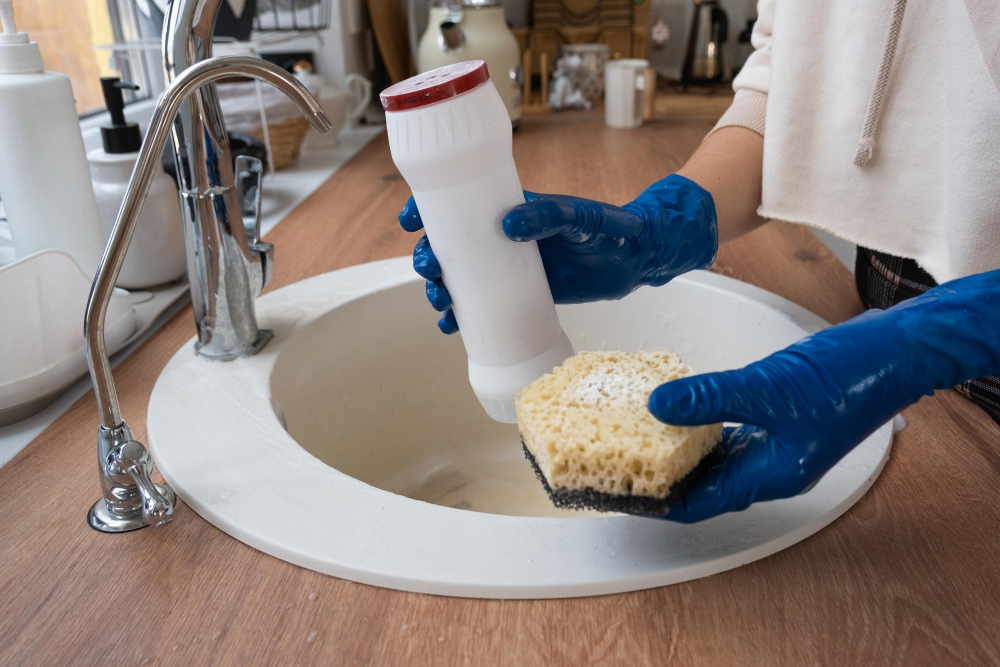
These stains can be caused by food particles, soap scum, or hard water deposits. To keep your sink looking its best, it’s important to clean it regularly.
For regular cleaning of surface stains on porcelain kitchen sinks, you’ll need a mild cleaner and a soft sponge or cloth. Start by wetting the sink with warm water and then apply the cleaner directly onto the stained areas.
Let it sit for a few minutes before scrubbing gently with your sponge or cloth.
Avoid using abrasive cleaners that contain bleach or ammonia as these can damage the porcelain finish of your sink over time.
Once you’ve finished scrubbing away any visible dirt and grime from all parts of your porcelain kitchen sink including around faucets edges etc., rinse thoroughly with warm water to remove any remaining residue from cleaning products used earlier in this process.
Tougher Stains and Deep-Cleaning
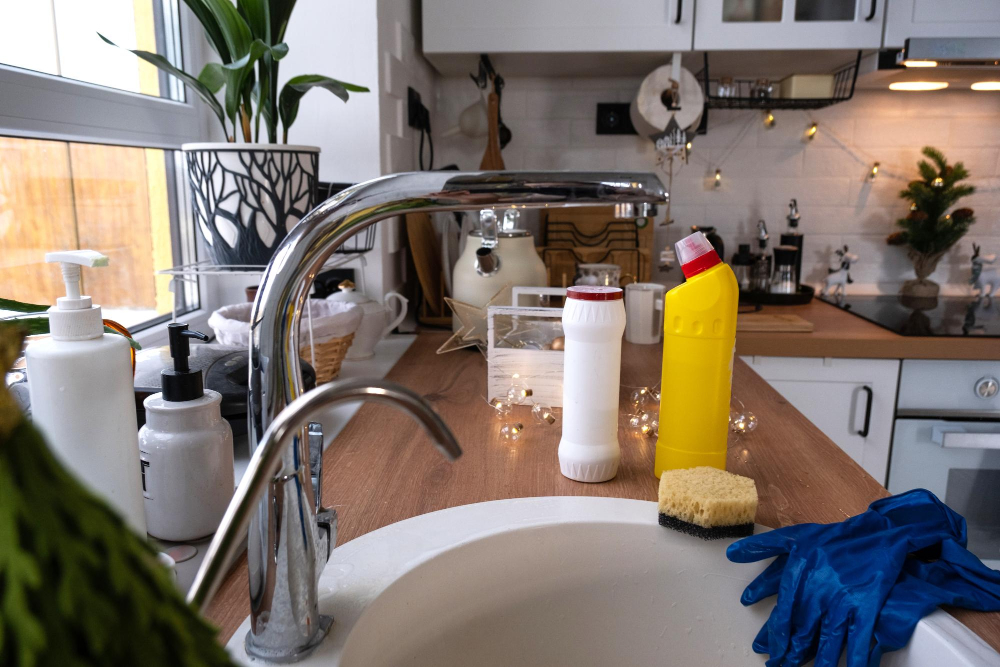
For example, rust or hard water stains can be particularly stubborn to remove.
To tackle these types of stains, you’ll need to use a more powerful cleaner and some elbow grease. One effective method is to create a paste using baking soda and water.
Apply the paste directly onto the stain and let it sit for 10-15 minutes before scrubbing with a soft sponge or brush.
Another option is to use white vinegar mixed with baking soda as an alternative solution for tough-to-remove grime on your porcelain sink surface.
For really tough metal stains like those caused by iron deposits in well-water systems, try using Bar Keepers Friend powder cleanser which contains oxalic acid that helps dissolve mineral buildup without damaging the finish of your porcelain kitchen sink.
Scrubbing Techniques
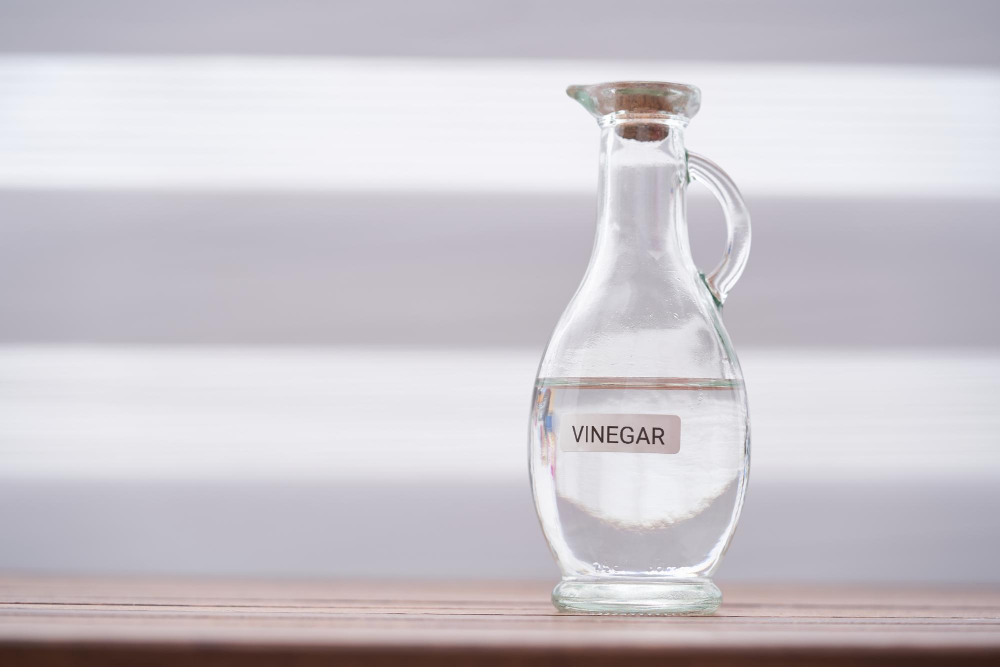
Harsh scrubbers or abrasive cleaners can scratch the surface of your sink and cause permanent damage. Instead, opt for a soft sponge or cloth and use a circular motion when cleaning.
For tougher stains that won’t come off with regular cleaning, try using baking soda mixed with water to create a paste. Apply the paste directly onto the stain and let it sit for 10-15 minutes before gently scrubbing away with a soft sponge.
Another option is using white vinegar mixed with water in equal parts as an all-purpose cleaner for your porcelain sink. The acidity of vinegar helps break down tough stains while being gentle on the surface of your sink.
Remember not to apply too much pressure when scrubbing as this can lead to scratches on the surface of your porcelain kitchen sink.
Use a Soft Sponge

One of the most crucial tools you’ll need is a soft sponge. Porcelain sinks are delicate and can easily scratch or chip if you use abrasive materials like steel wool or rough scrub brushes.
To avoid damaging your sink’s surface, choose a soft sponge that won’t scratch or leave marks on your porcelain finish. You can find sponges specifically designed for cleaning delicate surfaces at any home goods store.
When using a sponge to clean your sink, be sure to apply gentle pressure and use circular motions rather than back-and-forth scrubbing. This will help prevent scratches and keep your porcelain looking shiny and new for years to come.
Removing Metal Stains From Porcelain Sinks
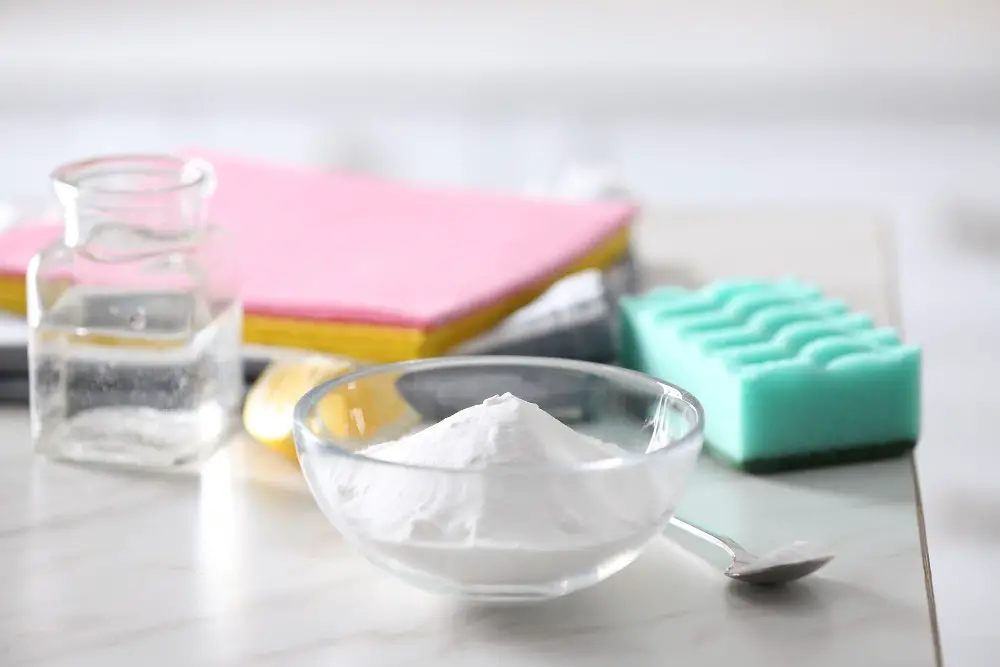
- Choose a Cleaner
- Surface Stains and Regular Cleaning
- Tougher Stains and Deep-Cleaning
Removing Metal Stains from Porcelain Sinks:
Metal stains are one of the most common types of stains that can occur on porcelain sinks, especially if you have hard water or use metal utensils in your sink regularly. These stains can be stubborn to remove but with the right technique, it’s possible to get rid of them completely.
To remove metal stains from your porcelain sink, start by wetting the surface with warm water and then sprinkle baking soda over the affected area until it forms a paste-like consistency.
Next, take a soft-bristled brush or sponge and gently scrub the stained area in circular motions for several minutes until you see some improvement.
Cleaning Colored Porcelain Sinks Safely

Harsh chemicals or abrasive scrubbers can damage the finish and cause discoloration. To clean your colored porcelain sink safely, start by using a mild cleaner that is specifically designed for use on porcelain surfaces.
Avoid using bleach or other harsh chemicals as they can strip away the color from your sink over time. Instead, opt for natural cleaners like baking soda and vinegar which are gentle yet effective at removing stains and grime without damaging the surface of your sink.
When cleaning a colored porcelain sink, always use soft sponges or cloths to avoid scratching its delicate surface. Avoid using steel wool pads or abrasive brushes as they can leave unsightly scratches on the finish of your beautiful kitchen fixture.
Rinse the Sink
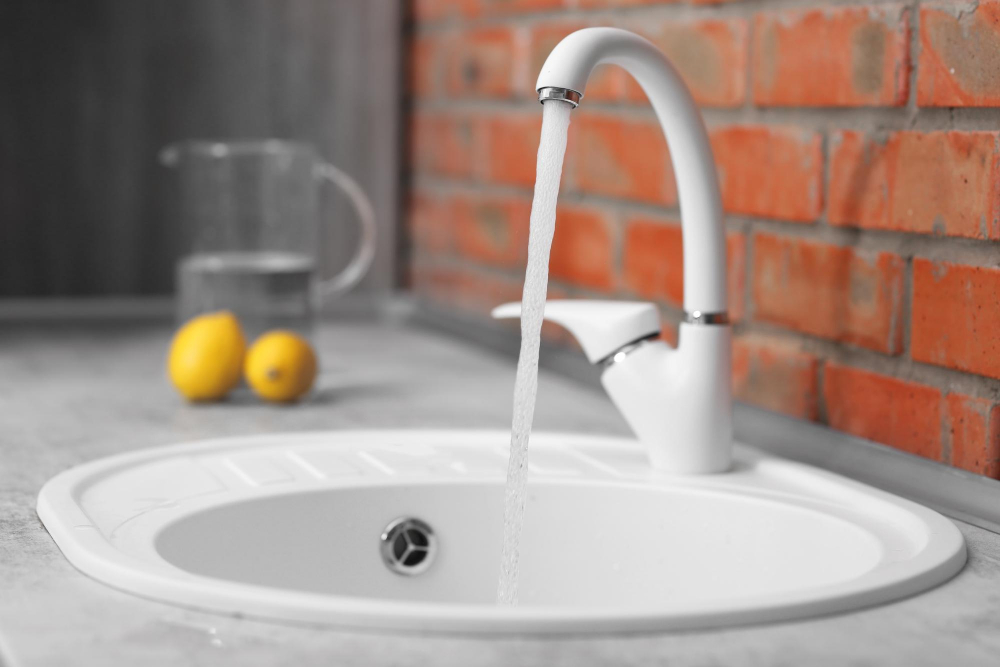
Use warm water to thoroughly rinse every inch of the sink surface. Make sure that there is no residue left behind from any cleaning products or soap.
After rinsing, use a clean cloth or sponge to wipe down the entire surface of your porcelain kitchen sink. This will help remove any remaining dirt and grime while also ensuring that your sink is completely dry.
Remember, leaving water droplets on a porcelain surface can lead to unsightly stains over time so make sure you dry it well after each use as well as after deep-cleaning sessions like this one!
Dry the Sink
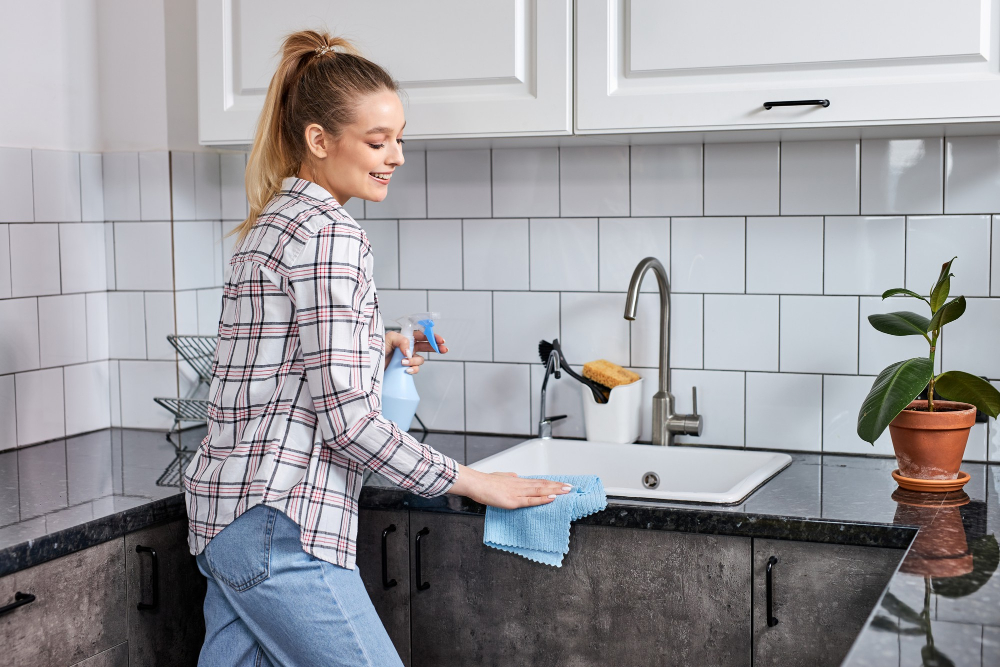
Drying your porcelain kitchen sink is an important step in preventing water spots and mineral buildup. You can use a soft cloth or towel to wipe down the surface of the sink until it’s completely dry.
If you want to avoid any streaks or marks on your porcelain kitchen sink, consider using a microfiber cloth for drying instead of a regular towel. Microfiber cloths are gentle on surfaces and absorb moisture quickly without leaving behind any lint or residue.
It’s also important not to leave standing water in your porcelain kitchen sink as this can lead to discoloration over time. So make sure that you always dry out your sink after each use.
Maintaining Shine and Brightness of Porcelain Sinks
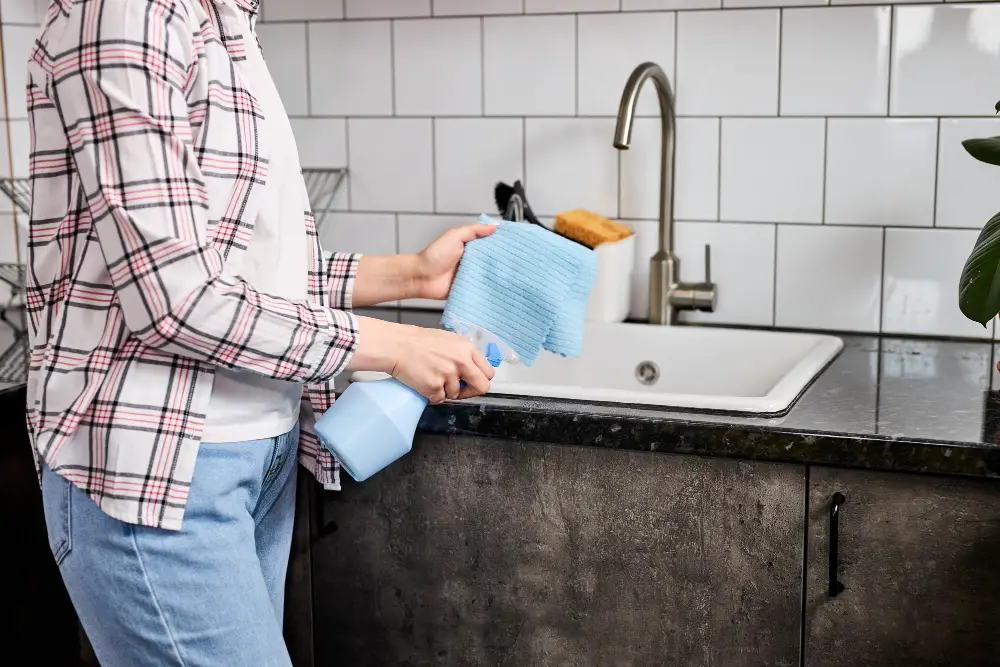
One of the easiest ways to do this is by wiping down the sink after each use with a soft cloth or sponge. This will prevent water spots and soap scum from building up on the surface of your sink.
Another way to keep your porcelain sink looking like new is by using a protective coating such as car wax or furniture polish. Simply apply a small amount of wax or polish onto a clean, dry cloth and rub it into the surface of your sink in circular motions until you achieve an even coat.
It’s also essential that you avoid using abrasive cleaners on your porcelain kitchen sinks as they can scratch and damage their surfaces over time. Instead, opt for gentle cleaning solutions such as baking soda paste mixed with water which can be used once every few weeks for deep-cleaning purposes.
Regular Maintenance Tips

Here are some tips for regular maintenance of your porcelain sink:
1. Rinse the Sink After Each Use: Make sure to rinse out any food particles or debris after each use.
2. Wipe Down the Sink Daily: Use a soft cloth or sponge to wipe down the surface of your sink daily.
3. Avoid Harsh Cleaners: Avoid using harsh chemicals that can damage the surface of your porcelain sink.
4. Don’t Let Stains Sit Too Long: If you notice any stains on your sink, try to clean them as soon as possible before they become more difficult to remove.
5. Be Gentle with Your Sink: Porcelain sinks can be easily scratched or chipped if not handled carefully, so avoid dropping heavy objects in it and don’t use abrasive scrubbers on its surface.
Avoid Harmful Products
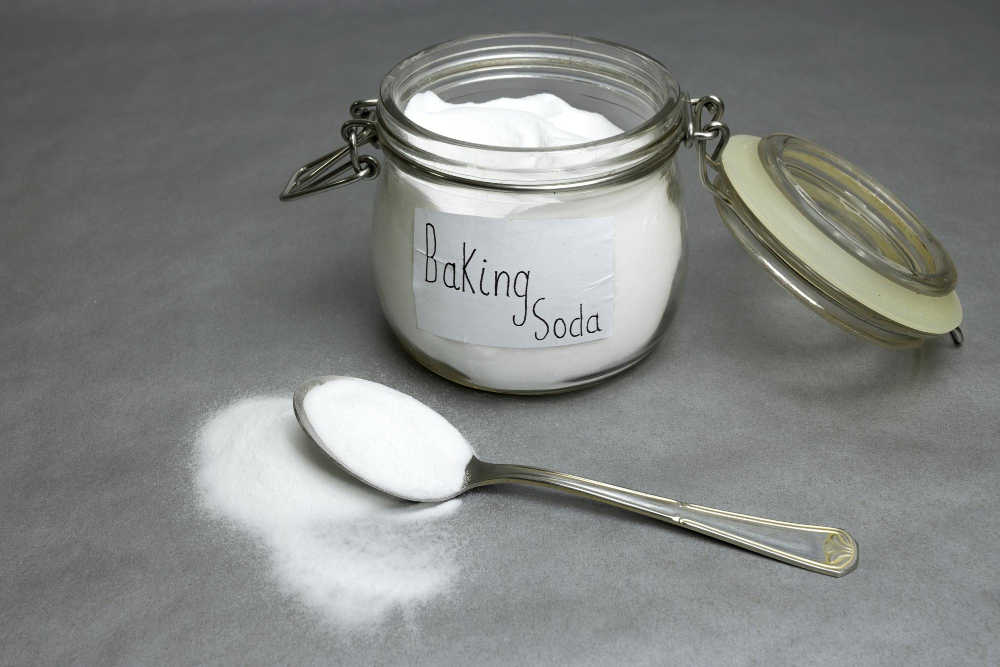
Avoid harsh chemicals like bleach or ammonia-based cleaners as they can damage the surface of your sink over time. Abrasive cleaners such as scouring powders or steel wool should also be avoided because they can scratch the surface of your porcelain sink.
Instead, opt for gentle yet effective cleaning solutions like baking soda and vinegar. Baking soda is a natural abrasive that helps remove stains without scratching the surface while vinegar has acidic properties that help dissolve mineral deposits and soap scum.
Another thing to keep in mind is not to mix different types of cleaners together as this could create toxic fumes which are harmful when inhaled. Always read labels carefully before using any product on your porcelain kitchen sink.
Preventing Scratches and Damage
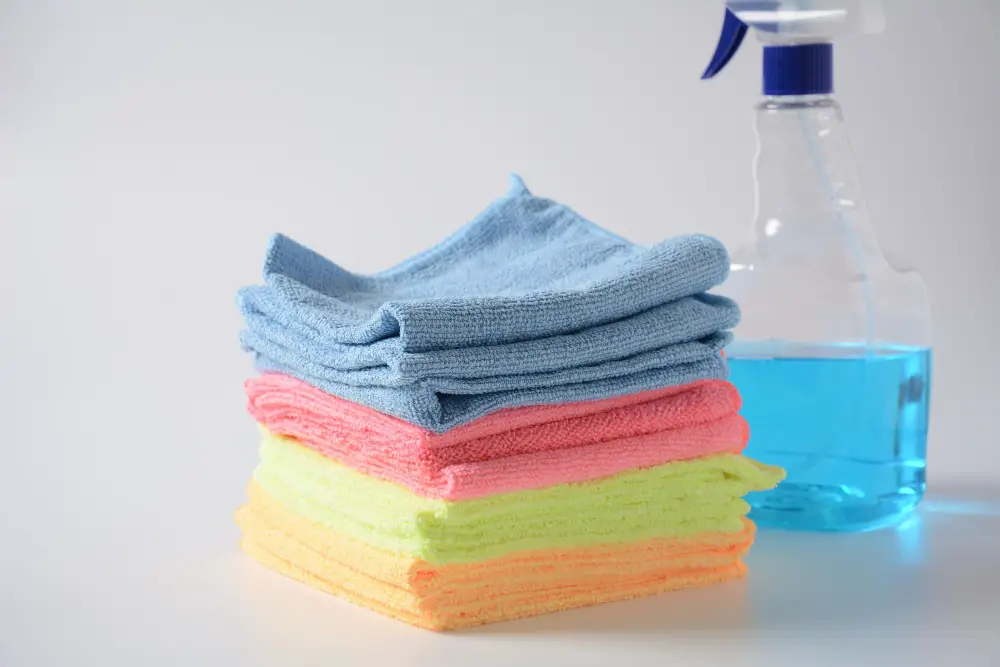
To prevent scratches, avoid using abrasive cleaners or scrubbers on your sink’s surface. Instead, use a soft sponge or cloth to clean the sink gently.
Another way to prevent damage is by avoiding heavy impact on the porcelain surface. Dropping heavy objects like pots and pans into the sink can cause chips and cracks in your porcelain kitchen sink.
To protect your porcelain kitchen sink from scratches caused by utensils such as knives and forks, consider investing in a protective mat that sits at the bottom of your basin.
Eco-friendly Cleaning Options
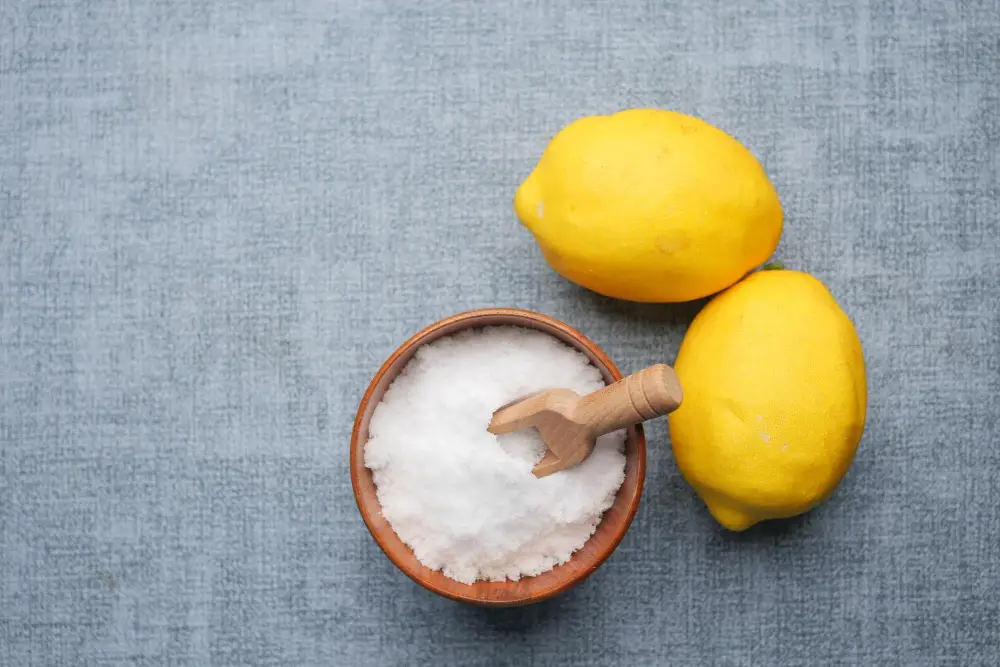
One of the most popular is using baking soda and vinegar. Simply sprinkle some baking soda on the surface of your sink, then spray it with vinegar until it starts to fizz.
Let this sit for a few minutes before scrubbing with a soft sponge or brush.
Another eco-friendly option is using lemon juice and salt. Cut a lemon in half and dip one half into some salt, then use this as an abrasive cleaner on your sink’s surface.
You can also try making your own all-purpose cleaner by mixing equal parts water and white vinegar in a spray bottle. This solution can be used not only on porcelain sinks but also other surfaces around the house.
FAQ
What is the best cleaner for porcelain sinks?
The best cleaner for porcelain sinks is a combination of hydrogen peroxide and oxygen bleach, as they are the most effective household cleaners for tough stains on antique or colored porcelain.
How do you get stains out of a porcelain sink?
To remove stains from a porcelain sink, spray undiluted white vinegar on the sink, clean it with a non-abrasive sponge using circular motions, and rinse thoroughly with water.
Does Magic Eraser work on porcelain sink?
Yes, Magic Erasers can be safely used on porcelain sinks and ceramic tiles without causing any damage.
How can I maintain the shine of a porcelain sink after cleaning?
To maintain the shine of a porcelain sink after cleaning, periodically apply a layer of lemon juice or white vinegar, let it sit for a few minutes, then rinse and dry with a soft cloth.
Are there any homemade cleaning solutions suitable for porcelain sinks?
A suitable homemade cleaning solution for porcelain sinks consists of combining baking soda and warm water.
What precautions should be taken to prevent damage while cleaning a porcelain sink?
To prevent damage while cleaning a porcelain sink, use a gentle cleanser, avoid abrasive materials, and protect the surface with a soft cloth.




